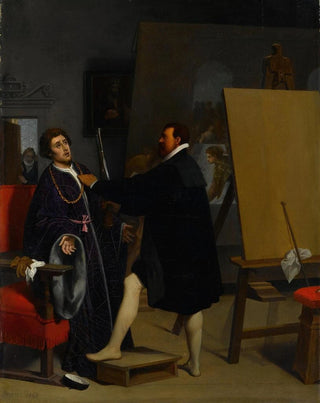Art print | L'Arétin in Tintoret's workshop - Jean-Auguste-Dominique Ingres


View from behind

Frame (optional)
In the vast panorama of art history, some works stand out for their ability to capture the essence of an era while transcending time. "The Arétin in Tintoret's workshop" by Jean Auguste Dominique Ingres is one of these masterful pieces. This artwork, which immerses the viewer in the intimacy of a 16th-century artistic studio, evokes not only the relationship between the artist and his model but also the richness of a cultural dialogue between the past and the present. Ingres, a master of Neoclassicism, invites us to explore the subtleties of artistic creation through the lens of this vibrant and profoundly human representation.
Style and uniqueness of the work
Ingres's style, characterized by meticulous precision and particular attention to detail, reaches its peak in this piece. The composition is skillfully orchestrated, where each element, from Arétin's body to the sumptuous drapery, contributes to a captivating visual harmony. The light, soft and diffuse, caresses the surfaces, revealing the textures of fabrics and the flesh of the characters with extraordinary delicacy. Ingres does not merely reproduce reality; he idealizes it, while maintaining a certain truth in expressions and postures. This duality between idealization and realism is the very essence of his art, and "The Arétin in Tintoret's workshop" is a striking illustration of this. The artwork manages to capture the intensity of the moment, offering the viewer a window into the creativity and vibrancy of the studio.
The artist and his influence
Jean Auguste Dominique Ingres, an emblematic figure of Neoclassicism, knew how to leave his mark on his time with his unique vision of art. His training under Jacques-Louis David and his immersion in classical currents shaped his artistic approach. Ingres does not limit himself to simple imitation of the masters; he reinterprets and reinvents, integrating elements of tradition while adapting them to his personal sensibility. His influence extends well beyond his era, inspiring generations of artists to explore the boundaries of representation. "The Arétin

Matte finish

View from behind

Frame (optional)
In the vast panorama of art history, some works stand out for their ability to capture the essence of an era while transcending time. "The Arétin in Tintoret's workshop" by Jean Auguste Dominique Ingres is one of these masterful pieces. This artwork, which immerses the viewer in the intimacy of a 16th-century artistic studio, evokes not only the relationship between the artist and his model but also the richness of a cultural dialogue between the past and the present. Ingres, a master of Neoclassicism, invites us to explore the subtleties of artistic creation through the lens of this vibrant and profoundly human representation.
Style and uniqueness of the work
Ingres's style, characterized by meticulous precision and particular attention to detail, reaches its peak in this piece. The composition is skillfully orchestrated, where each element, from Arétin's body to the sumptuous drapery, contributes to a captivating visual harmony. The light, soft and diffuse, caresses the surfaces, revealing the textures of fabrics and the flesh of the characters with extraordinary delicacy. Ingres does not merely reproduce reality; he idealizes it, while maintaining a certain truth in expressions and postures. This duality between idealization and realism is the very essence of his art, and "The Arétin in Tintoret's workshop" is a striking illustration of this. The artwork manages to capture the intensity of the moment, offering the viewer a window into the creativity and vibrancy of the studio.
The artist and his influence
Jean Auguste Dominique Ingres, an emblematic figure of Neoclassicism, knew how to leave his mark on his time with his unique vision of art. His training under Jacques-Louis David and his immersion in classical currents shaped his artistic approach. Ingres does not limit himself to simple imitation of the masters; he reinterprets and reinvents, integrating elements of tradition while adapting them to his personal sensibility. His influence extends well beyond his era, inspiring generations of artists to explore the boundaries of representation. "The Arétin






